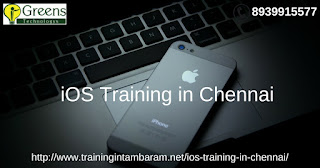Swift Programming in iOS
What is Swift?
Swift is Apple's new PC programming dialect for iOS also, Mac. Before Swift, Apple engineers composed projects in Objective-C, which Apple did not make. Apple repaired, what's more, knew they expected to make their own dialect that they could control and started subtly making Swift in 2010! Swift was reported on June 2, 2014. The two iOS and Mac applications can be written in Swift.
What’s so special about Swift?
• Projects have a tendency to be short, which implies less composing, less code, and less shot of bugs and glitches!
• Program language is to a great degree English-like and can be seen effortlessly. That implies less remembering for you!
• Apple is the creator of Swift dialect so they have finish control over it. In the event that heaps of developers experience difficulty with some punctuation (programming sentence structure), Apple can transform it at whatever point they need to improve it.
• Apple presented another element called Playgrounds. Play areas are incredible on the grounds that they enable you to test your code continuously. You can test, play around and take in a considerable measure of code even before you incorporate it in your application. This implies simple code testing for you! While I was taking in this dialect and attempting to make applications in it, I felt that there were not really any assets to enable me to continue proceeding.
Swift can’t do everything:
Swift is extraordinary, be that as it may, similar to any programming dialect, it can't do everything. Progressed developers frequently utilize highlights of different dialects in their Swift projects. We'll need to utilize a smidgen of Objective-C and a tad of Cocoa later in this book – an extremely smidgen! They are entangled dialects all alone, yet I need to demonstrate to you some extraordinary things that you can just do by including parts of different dialects in Swift.
Gather hardware:
The time has come to make an agenda and assemble the equipment and programming to begin making applications. In this area, you will learn precisely what equipment you require, how to introduce the product and the records you might need to make with Apple.
You need the accompanying equipment to introduce Xcode and build up your applications in Swift:
• Macintosh with at any rate OS X Yosemite (10.10.5) and no less than 6 GB of free hard circle space; any Mac work area or PC that meets these necessities will do. You should have it to make Apps.
• Optional: iPhone (4S or more up to date), iPod (5 or more up to date), iPad (2 or more up to date), iPad Mini (any age), or iPad Air (any age), iPad Pro (any age).
• No iDevice? On the off chance that you don't have an iDevice at this moment, you can utilize the free the test system that is now included with Xcode.
Defining the Interaction:
After you lay out your UI, you have to give clients a chance to cooperate with it. This is the place controllers come in. Controllers bolster your perspectives by reacting to client activities and populating the perspectives with content. Controller objects are a course through which sees find out about changes in the information model and the other way around. Perspectives are informed of changes in show information through the application's controllers, and controllers convey client started changes—for instance, content entered in a content field—to display objects. Regardless of whether they're reacting to client activities or characterizing route, controllers execute your application's conduct.
View Controllers:
After you've manufactured a fundamental view chain of command, your subsequent stage is to control the visual components and react to client enter. In an iOS application, you utilize a view controller (UIViewController) to deal with a substance see with its chain of the importance of subviews.
A view controller isn't a piece of the view pecking order and it is anything but a component in your interface. Rather, it deals with the view protests in the progressive system and gives them conduct. Each substance sees the chain of importance that you work in your storyboard needs a relating view controller, in charge of dealing with the interface components, what's more, performing assignments in light of client association. This generally implies composing a custom UIViewController subclass for each substance see a chain of command. In the event that your application has various substance sees, you utilize an alternate custom view controller class for each substance see.
View controllers assume numerous parts. They arrange the stream of data between the application's information show and the perspectives that show that information, deal with the lifecycle of their substance perspectives, and handle introduction changes when the gadget is turned. Be that as it may, maybe their most clear part is to react to client include.
You likewise utilize see controllers to actualize changes starting with one sort of substance then onto the next. Since iOS applications have a restricted measure of room in which to show content, see controllers give the framework expected to expel the perspectives from one view controller and supplant them with the perspectives of another.
To characterize association in your application, make your view controller documents speak with the perspectives in your storyboard. You do this by characterizing associations between the storyboard and source code records through activities and outlets.
Controls:
A control is a UI question, for example, a catch, slider, or switch that clients control to communicate with content, give input, explore inside an application, and perform different activities that you characterize. Controls give a path to your code to get messages from the UI.
At the point when a client interfaces with a control, a control occasion is made. A control occasion speaks to different physical signals that clients can make on controls, for example, lifting a finger from a control, dragging a finger onto a control, and touching down inside a content field.
There are three general classifications of occasion composes:
● Touch and drag occasions. Touch and drag occasions happen when a client cooperates with a control with a touch or drag. There are a few accessible touch occasion stages. At the point when a client at first touches a finger on a catch, for instance, the Touch Down Inside occasion is activated; if the client drags out of the catch, the individual drag occasions are activated. Touch Up Inside is sent when the client lifts a finger off the catch while still inside the limits of the catch's edges. On the off chance that the client has dragged a finger outside the catch before lifting the finger, adequately wiping out the touch, the Touch Up Outside occasion is activated.
● Editing occasions. Altering occasions happen when a client alters a content field.
● Value-changed occasions. Esteem changed occasions happen when a client controls a control, making it transmit a progression of various qualities.
iOS @ Greens Technology
A step-by-step iOS Training Chennai to building an iPhone or iPad app for Beginners. This course is designed for beginners who have never coded in Objective-C or build an iOS app. Greens Technology provides best iOS Training in Chennai.



Comments
Post a Comment